DJI drone tips and tricks

Master Your DJI Drone with These Tricks
Welcome to the ultimate guide for maximizing your DJI drone experience. Whether you're a beginner or an experienced pilot, there are always new ways to improve your skills and get better shots. This article covers essential settings, battery life tips, camera adjustments, navigation techniques, and more.
Essential DJI Drone Settings Explained
To start off, it's crucial to understand the key settings on your DJI drone that can significantly impact performance and functionality:
- Flight Mode: Choose between different modes such as Sport for high-speed maneuvers or Tripod for slow and steady flying.
- Battery Settings: Optimize battery usage by adjusting power-saving options like low-power mode, which reduces camera resolution to extend flight time.
- Sensor Calibration: Ensure accurate data from your drone’s sensors by regularly calibrating them for optimal performance.
Boost Battery Life on Your DJI Drone
Battery life is a critical factor in drone operation. Here are some tips to maximize it:
- Use Efficient Flight Patterns: Plan your flight paths efficiently to avoid unnecessary battery drain.
- Avoid Extreme Temperatures: Cold weather can drastically reduce battery life, so keep your drone warm before flying.
- Reduce Camera Settings: Lower the resolution and frame rate of your camera when you don't need high-quality footage.
Perfect Shots with DJI Camera Settings
To get stunning aerial shots, tweak these settings on your drone’s camera:
- Exposure Compensation: Adjust the exposure to brighten or darken scenes according to lighting conditions.
- ISO Control: Lower ISO in well-lit areas and increase it for low-light situations to maintain image quality.
- White Balance: Set appropriate white balance settings (auto, sunny, cloudy) to ensure accurate colors.
Navigate Like a Pro with DJI GPS
Your drone’s GPS system is your best friend for navigation. Here’s how to make the most of it:
- GPS Lock: Ensure you have a strong GPS signal before takeoff.
- Return-to-Home Function: Configure this feature to automatically return your drone home when battery is low or control signal is lost.
- Waypoint Navigation: Use waypoints for precise flight paths and automated missions.
Extend Range for Better FPV Flying
First-person view (FPV) flying requires a long-range connection. Here’s how to achieve that:
- Upgrade Antennas: Replace stock antennas with high-gain models.
- Use Repeaters: Install signal repeaters to extend the range of your video transmission.
- Optimize Flight Path: Plan your flight path to avoid obstacles and maintain a clear line-of-sight for better signal strength.
Customize DJI Controller for Comfort
A comfortable controller means better control over your drone. Consider these customization ideas:
- Joystick Adjustments: Change the position and tension of joysticks to suit your grip.
- Button Layouts: Reassign buttons for easier access to frequently used functions.
- Ergonomic Grips: Add ergonomic grips or cases that fit your hand perfectly.
Tips for Smooth FPV Flying
Flying in first-person view requires a different set of skills. Here are some tips to help you fly smoothly:
- Practice Hovering: Start by practicing hovering at different altitudes before moving on to more complex maneuvers.
- Use Head Tracking: Many FPV goggles allow for head tracking, which can enhance your control over the drone’s movements.
- Monitor Battery Levels: Keep an eye on battery levels and return home before it gets too low to ensure smooth operation.
How to Calibrate DJI Sensors
Sensor calibration is crucial for accurate flight data. Follow these steps:
- Magnetometer Calibration: Perform magnetometer calibration regularly to correct magnetic interference.
- Gyro Sensor Calibration: Ensure your gyro sensors are calibrated for smooth and stable flights.
- Accelerometer Calibration: Calibrate the accelerometer to ensure accurate altitude readings.
Advanced Flight Modes on DJI Drones
DJI drones offer a variety of advanced flight modes that can enhance your aerial photography and videography experience. Here’s what you need to know:
- Follow Me Mode: This mode allows the drone to track and follow a moving subject automatically.
- Tornado Mode: Create dynamic, swirling movements for unique aerial shots.
- Obstacle Avoidance: Activate obstacle avoidance sensors to prevent collisions with objects in your flight path.
Maximize Range with DJI Antennas
To extend the range of your drone, consider upgrading or customizing your antennas:
- Replace Stock Antennas: Replace stock antennas with high-gain models for better signal strength.
- Add External Amplifiers: Use external amplifiers to boost the range of your video transmission.
- Use Directional Antennas: Install directional antennas to focus the signal in a specific direction, increasing overall range.
Conclusion
In conclusion, mastering your DJI drone involves understanding and utilizing its various features effectively. From optimizing battery life to navigating with precision, each tip and trick contributes to enhancing your aerial photography experience. By implementing these strategies, you'll be well on your way to becoming a proficient and skilled drone pilot.

